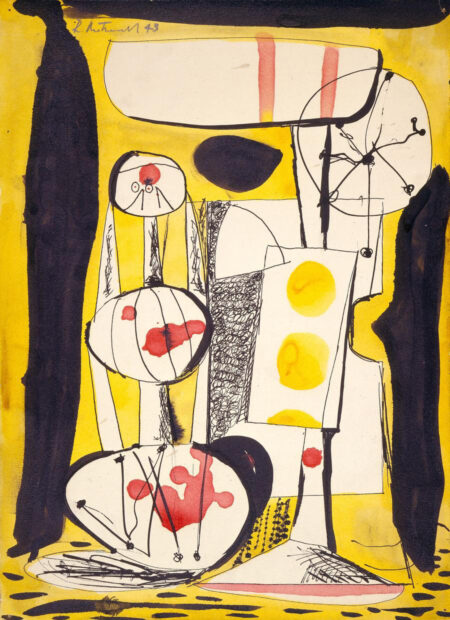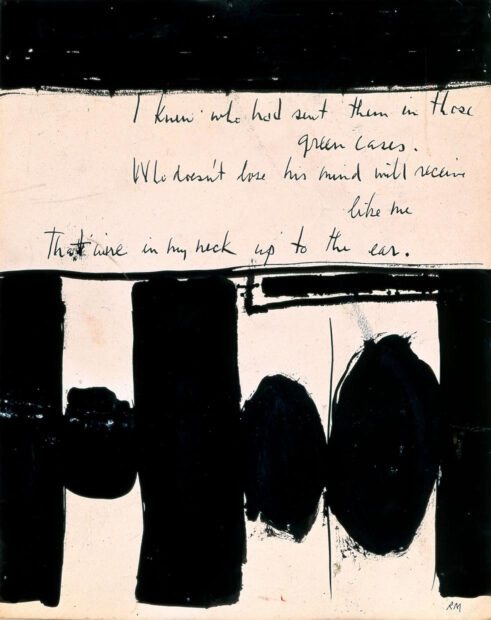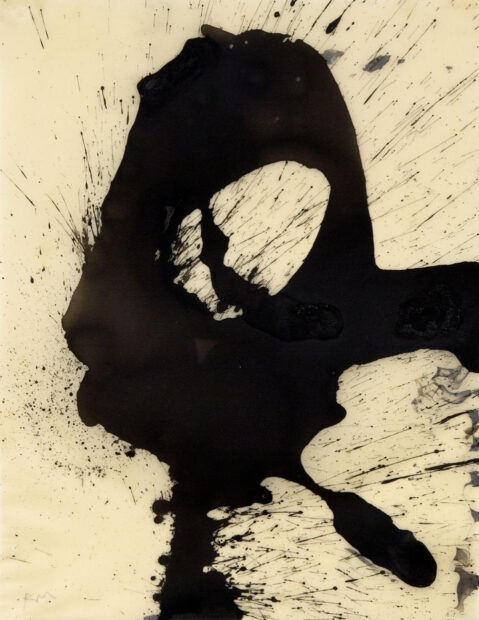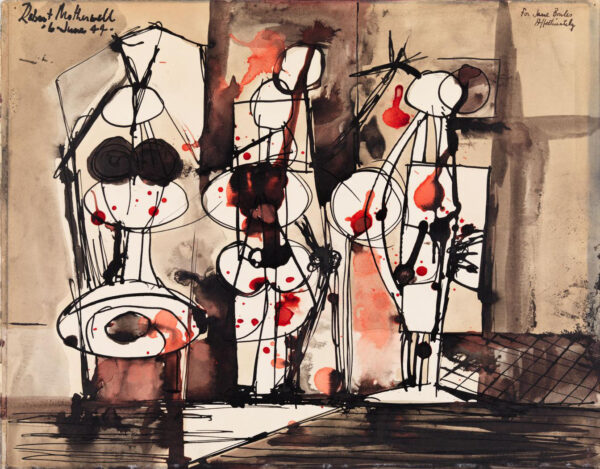
Robert Motherwell, Untitled, 1973, watercolor and ink on paperboard, 15 x 11 inches. The Menil Collection, Houston © 2022 Dedalus Foundation, Inc/Artists Rights Society (ARS), NY
“When I wake up in the morning,” author Hanif Kureishi wrote in his January 8, 2023 dispatch from the Kureishi Chronicles, a daily newsletter the writer has kept since his near-fatal fall in Italy, “the first thing I do is make my coffee and go upstairs to my desk which overlooks the street. Around the edge of the desk I have hundreds of fountain pens, pencils, markers…I pick up a pen and make a mark on a page of good thick paper, then I make another mark, then I write a word, a sentence, than another sentence, until I feel something wake up inside me.”
Art in any form is an alchemy between the artist and their tools. Like Kureishi, the artist Robert Motherwell led with this spontaneity of meaning-making, allowing the mark to reveal its purpose in time. One of the early Abstract Expressionists, he followed the automatic techniques of the Surrealists to present a sense of possibility and wonder on the page, working as much with accident as intuition — a spilled pot of ink, a rip in the paper. In this way, he respected the material enough to let it guide him towards a visual lexicon he modified throughout his life.

Robert Motherwell, “Elegy to the Spanish Republic No. 1,” 1948, ink on paper, 10 3/4 x 8 1/2 inches. The Museum of Modern Art, New York. Gift of the artist, 1988 © 2022 the Dedalus Foundation, Inc/ Artists Rights Society (ARS), NY.
As Fast as the Mind Itself, a collection of Motherwell’s drawings spanning four decades, currently on view at the Menil Drawing Institute in Houston, delivers on the immediacy of creative impulse and the subconscious’ tireless inventions. The show is organized by the Menil Drawing Institute’s chief curator Edouard Kopp, and is on display at the same time as the publication of Robert Motherwell Drawings: A Catalogue Raisonné’s, which was named one of the best ten art books of 2022 by Brooklyn Rail.
The As Fast as the Mind Itself exhibition pamphlet reads, “[Motherwell] employed a wide range of supports and mediums, and he drew with different purposes in mind — exploration, study, preparation, or sheer pleasure.” Both pleasure and preparation are apparent in the gallery space. The cobalt blue art of Beside the Sea No. 15 (1962), for instance, betrays a playful and loving hand as it lingers over a solid streak of mauve and forest green, like a single cloud over an endless ocean.

Installation view of “Robert Motherwell Drawing: As Fast as the Mind Itself” at the Menil Drawing Institute, Houston. Photo: Paul Hester.
Motherwell’s Lyric Suite (1965), a set of over 20 ink on paper drawings, could fall within any of the categories listed above. Mounted on a prominent gallery wall, the curators let the viewer decide in which one to lump them. This set of drawings ranges from the almost-figurative — shapes reminiscent of a caterpillar or a slug — to a fidelity to the line and its abstract wisdom. According to the Dedalus Foundation, Lyric Suite was conceived by Motherwell as visual representations of musical variations. The pieces were neither revised nor reflected upon, and thus, not judged. “Give up one’s being to the enterprise,” Motherwell maintained of his intention behind the series, “and see what lies within, whatever it is. Venture. Don’t look back.”
Drawings from the artist’s Mexican Sketchbook (1941) reveal the loom of the unexplainable over the mechanics of a conscious mind. They feature dark clouds of black ink rubbing at the edges of delicate architectures of line drawings, dividing space into neat sections. It was in Mexico that painter Roberto Matta introduced Motherwell to automatism, a technique used to pull the brain’s chatter away from the process of art-making. It is a process devoid of ego, one in which the artist watches their own hand “as though it is someone else’s.” This 1941 trip proved to be a turning point in Motherwell’s career, and he returned to Mexico for his very last exhibition at the Museo Rufino Tamayo and Museo del Monterrey in 1991.

Robert Motherwell, “Rimbaud Series No. 3,” 1967, tusche ink on parchment, 14 x 11 inches. Maxine and Stuart Frankel Foundation for Art, Bloomfield Hills, MI © 2022 Dedalus Foundation, Inc/Artists Rights Society (ARS), NY.
In his Elegies to the Spanish Republic (1948-1967) series, a set of over 100 paintings, Motherwell shifted his focus to the geometric, painting with more intention than his automated works, and with a funerary air. Elegy to the Spanish Republic No. 1 (1948) conveys the absorbing darkness of the era in which Motherwell was working. In these pieces, one senses Motherwell’s search for visual clarity in an increasingly confounding world, rampant with senseless violence. Motherwell discovered the format for Elegies while creating an image to accompany a Harold Rosenberg poem for the avant-garde magazine Possibilities.

Robert Motherwell, “Three Figures Shot,” 1994, pen and ink wash on paper, 11 7/16 x 14 3/8 inches. Whitney Museum of American Art, New York. Purchase with funds from the Burroughs Wellcome Purchase Fund and the National Endowment for the Arts © 2022 Dedalus Foundation, Inc/Artists Rights Society (ARS), NY.
Born in 1915 in Aberdeen, Washington, Motherwell originally aspired to become a philosopher. While studying at both Harvard and Stanford, he was introduced to the idea of abstraction by Alfred North Whitehead. After meeting other young artists in Greenwich Village in New York City, Motherwell began applying these same philosophical ideas of paring down thought to the necessary basics to his visual language. This essentializing is apparent in the thick, sparse lines of pieces such as Drunk with Turpentine (1979), a mode somewhere between drawing and linguistics that he called “the calligraphic.”
Motherwell’s influences ranged from the personal to historical, the poetic to the philosophical. The result is a body of work that is rigorous while remaining deeply trusting of its source material, be it from the pages of Kafka or from the inside of the artist’s fast and fiercely complex mind.
Robert Motherwell Drawing: As Fast as the Mind Itself is on view at the Menil Drawing Institute until March 12, 2023


